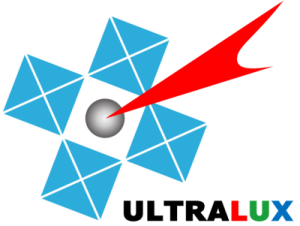Ultra-Lux Objectives
Thin-film light sources such as OLEDs are extremely valuable, as, in contrast to III-V crystalline LEDs, they can be precisely designed and dimensioned, as single components or in massive arrays, into any target application without the need of hetero-assembly. Unfortunately, their light power density remains about 300 times smaller than that of III-V LEDs. Also, none of today’s thin-film light sources could ever be brought to lasing by electrical pumping. It is the objective of this project to break through the barriers that limit the brightness of thin-film light sources and to achieve lasing by electrical pumping (“injection lasing”) in such sources.
Our first target is to create a high-brightness (30W/cm2) thin-film light-emitting device. For the emission layer, we propose a perovskite semiconductor with controlled quantum-confinement features (wells or dots). It will be integrated into a novel light-emitting device, in which electron and hole injection are separately controlled by gates, such that a perfect charge balance is achieved up to the highest current densities. Our next target is to create a thin-film injection laser. We present several innovative strategies to lower the lasing threshold. The emission layer of our light-emitting device will be shaped as a ring resonator with ultra-low optical losses. The gates will be patterned to spatially modulate the carrier injection in the emission layer, which will efficiently restrict the pumping to a few selected modes. Further elaborations of cavity designs can lead to mode-locking. Combined with the efficiency of the quantum-confined perovskite emission layer in producing optical gain, these features will reduce the lasing threshold current density to below 100 A/cm2, within reach of our thin-film device.
These novel devices will serve numerous applications in the fields of sensing and ICT, by enabling massive optical interconnects, augmented reality displays, on-chip sensing, and more.
Field of Science
-
- /natural sciences/physical sciences/optics/laser physics
- /natural sciences/physical sciences/electromagnetism and electronics/electrical conductivity/semiconductor
Programme(s)
H2020-EU.1.1. - EXCELLENT SCIENCE - European Research Council (ERC)
Topic(s)
ERC-2018-ADG - ERC Advanced Grant
Call for proposal
ERC-2018-ADG
See other projects for this call
Funding Scheme

Host Institution
imec
|
Address Kapeldreef 75, 3001 Leuven, Belgium |
Activity type Research Organisations |
EU Contribution € 2 497 493 |




